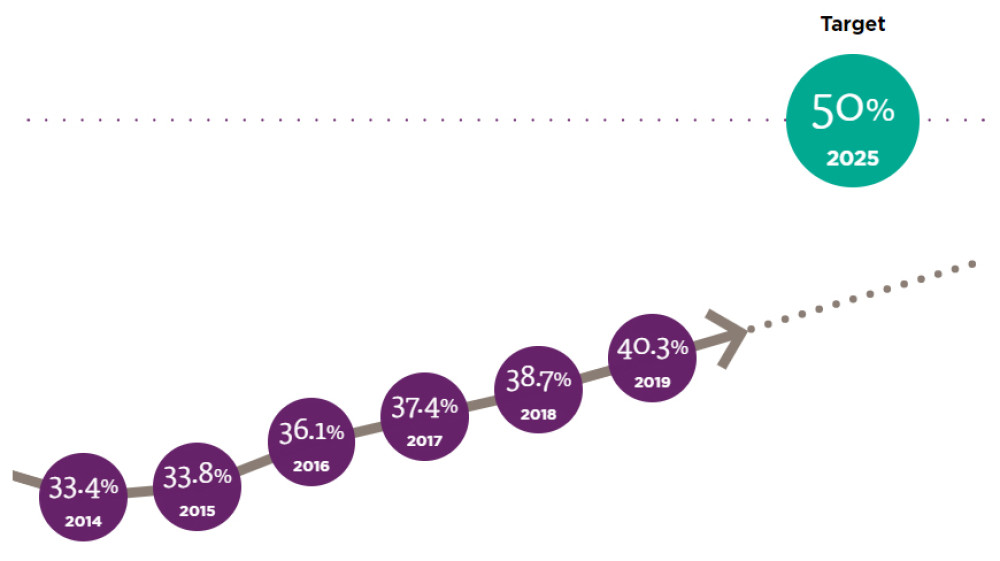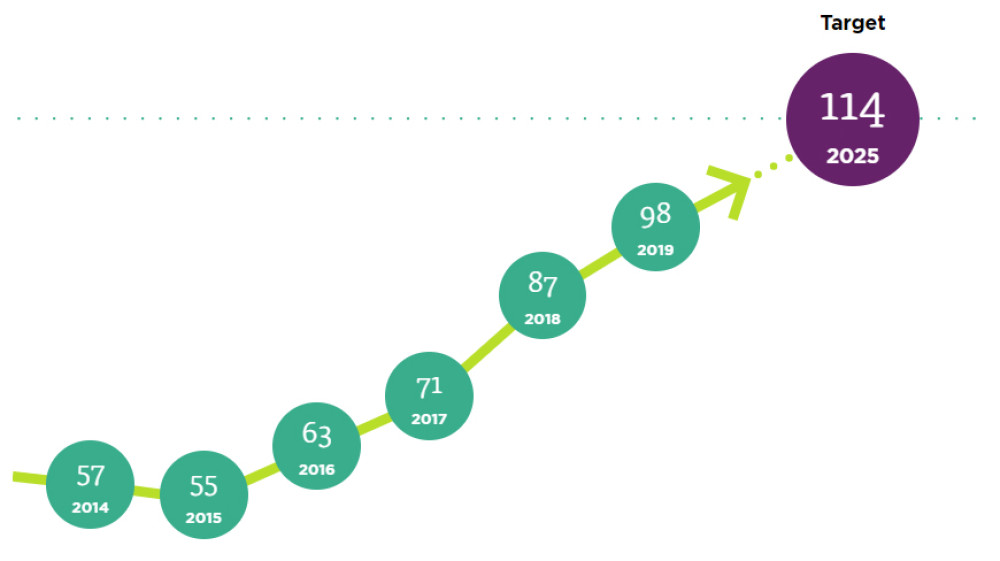Leaders
3,256 senior executives in the government sector
An important initiative in the first years of the NSW Public Service Commission was to simplify the executive structure. The Government Sector Employment Act 2013 (GSE Act) was introduced in part to simplify the executive structure and better support executive mobility. This work was further strengthened by the implementation of the Government Sector Employment Legislation Amendment Act 2016, which aligned the Senior Executive employment arrangements of the NSW Health Service, Transport Service and NSW Police Force with those of the Public Service.
| Service | 2018 | 2019 | Change (%) |
| Public Service | 2,051 | 2,140 | 4.3 |
| NSW Health Service | 160 | 181 | 13.1 |
| NSW Police Force | 66 | 69 | 4.5 |
| Teaching Service | 0 | 0 | 0.0 |
| Transport Service | 560 | 588 | 5.0 |
| Other Crown services | 278 | 278 | 0.0 |
| Total government sector | 3,115 | 3,256 | 4.5 |
| State owned corporations | 235 | 241 | 2.6 |
| External to government sector | 51 | 53 | 3.9 |
| Total public sector | 3,401 | 3,550 | 4.4 |
At June 2019, there were 3,550 senior executives in the public sector, with 3,256 in the government sector. This is an increase of 4.5% compared to the previous year.
The largest increase in Senior Executive numbers was in the Public Service. NSW Health Service also had a large percentage increase in senior executives, at 13.1%. Most of this increase is from eHealth and Health Infrastructure NSW, which both also had large increases in overall employee numbers.
Within the Public Service in 2019, 2,139 senior executives were employed under the four-band structure of the GSE Act as Public Service senior executives (PSSEs). These accounted for 99.95% of senior executives employed in the Public Service.
Figure 3.1 shows that the number of PSSEs on the census date had increased nearly to the level of 2014, the year the reforms were introduced. However, executive reductions implemented on 30 June 2019 are not reflected in these numbers as the census date for the 2019 workforce profile was 27 June. It is expected the number of PSSEs will have decreased after 30 June.
Figure 3.2 shows that in 2019, 80% of the executive cohort of PSSEs and aligned services executives were classified as Senior Executive Band 1, while 16.2% fell into Band 2 and only 3.8% into Band 3. The distribution of PSSEs and aligned services senior executives between bands is similar, with 79.4% of PSSEs and 81.3% of aligned services senior executives at Band 1, and an equal distribution of 3.8% at Band 3.
Progress on the Premier’s Priority to drive diversity in the government sector
Percentage of female senior leaders

Number of Aboriginal and Torres Strait Islander senior leaders

Improving diversity among senior leaders as part of achieving a world class public service is one of the Premier’s Priorities for 2019. The priority includes targets to double the number of Aboriginal and Torres Strait Islander senior leaders and achieve gender equity among senior leaders in the public sector by 2025.
There has been steady progress towards achieving these targets. The proportion of female senior leaders increased by 1.6 percentage points (pp) to 40.3% in 2019. Female representation in each band has increased each year since 2014; and cumulatively is up by 6.6pp for Band 1 senior leaders, 9.4pp for Band 2, and 12.4pp for Bands 3–4 since the targets were introduced1. Higher salary bands had lower representation of women than men, but the gap has narrowed since the target was introduced. Since 2016, the proportion of female leaders in Bands 3 and 4 combined has increased at approximately double the rate of Band 1 roles.
| Female senior leaders | 2014 (%) | 2015 (%) | 2016 (%) | 2017 (%) | 2018 (%) | 2019 (%) |
| Band 1 | 33.9 | 34.4 | 36.6 | 37.7 | 38.8 | 40.5 |
| Band 2 | 30.9 | 31.2 | 35.0 | 37.4 | 40.5 | 40.3 |
| Bands 3–4 | 22.2 | 20.8 | 24.8 | 28.3 | 30.6 | 34.6 |
| Total | 33.4 | 33.8 | 36.1 | 37.4 | 38.7 | 40.3 |
At a cluster level, the proportion of female senior leaders appears to have increased in all clusters in 2019 (see Table 3.3). Note that 2018 cluster data is an estimate only as cannot be completely mapped into the new clusters.2
| Cluster | 2018 (%) | 2019 (%) |
| Customer Service | 47.4 | 52.6 |
| Education | 54.3 | 54.8 |
| Health | 40.4 | 41.6 |
| Planning, Industry & Environment | 35.5 | 36.2 |
| Premier & Cabinet | 53.1 | 55.8 |
| Stronger Communities | 29.7 | 29.8 |
| Transport | 28.0 | 30.3 |
| Treasury | 44.3 | 45.6 |
| Total | 38.7 | 40.3 |
Three clusters were above the target of having 50% female senior leaders: Premier and Cabinet (55.8%), Education (54.8%) and Customer Service (52.6%). The two clusters with the lowest representation of female senior leaders were also those with a larger proportion of male employees: Stronger Communities (29.8% female senior leaders) and Transport (30.3% female senior leaders).
Despite this progress, projections based on recent turnover and gender ratios indicate that the sector will only have 42.1% female senior leaders in 2025 if this pattern continues. Modelling also indicates that the NSW Government could reach the target by 2025 if six in every 10 senior leader appointments are female.
The number of Aboriginal and Torres Strait Islander senior leaders increased between 2018 and 2019, from 87 to 98. The Education and Transport clusters accounted for much of the increase. Apart from a slight decrease in 2015, the number of Aboriginal and Torres Strait Islander senior leaders has increased each year since 2014, with the total increase at 71.9%.
| 2014 | 2015 | 2016 | 2017 | 2018 | 2019 | |
| Band 1 | 52 | 51 | 57 | 63 | 78 | 88 |
| Bands 2–4 | 5 | 4 | 6 | 8 | 9 | 10 |
| Total | 57 | 55 | 63 | 71 | 87 | 98 |
Figure 3.4 highlights that while most of the increase in the Aboriginal and Torres Strait Islander cohort occurred in the lower salary range (36 appointments), the number of Aboriginal and Torres Strait Islander senior leaders in Senior Executive Bands 2–4 has increased by five since 2014. Significant progress has been made towards the target of doubling the representation of Aboriginal and Torres Strait Islander peoples. If the current rate of increase continues, this target will be achieved by 2022.
It should be noted that increases in the proportion of female, and Aboriginal and Torres Strait Islander senior leaders in 2019 occurred in conjunction with an increase in the number of senior executives overall. Sustained increases in representation of female and Aboriginal and Torres Strait Islander senior leaders may be more challenging to achieve in a cohort that is decreasing in size.
Notes
1 Senior leaders are non-casual government sector employees earning $161,707 or more (2019) excluding Health Service roles of a specialist or technical nature with no leadership or managerial responsibilities and Justice roles of a statutory or institutional character (judges, magistrates and barristers). When displayed in Bands, these are aligned to the salary ranges of Public Service senior executives (PSSE), and Band 1 includes non-executives paid below the minimum PSSE salary level. Non casual government sector employees with salary equal to or higher than Senior Officer Grade 1, excluding Health roles of a specialist or technical nature with no leadership or managerial responsibilities and Justice roles with a statutory or institutional character (judges, magistrates and barristers).
2 Data is presented in the 1 July 2019 cluster structure, and 2018 data should be considered indicative only except for the Health and Transport clusters. For the other clusters, some parts of departments and agencies that moved under the MOG changes effective 1 July 2019 cannot be identified in earlier years’ data, so pre-2019 cluster data and comparisons to 2019 are estimates.